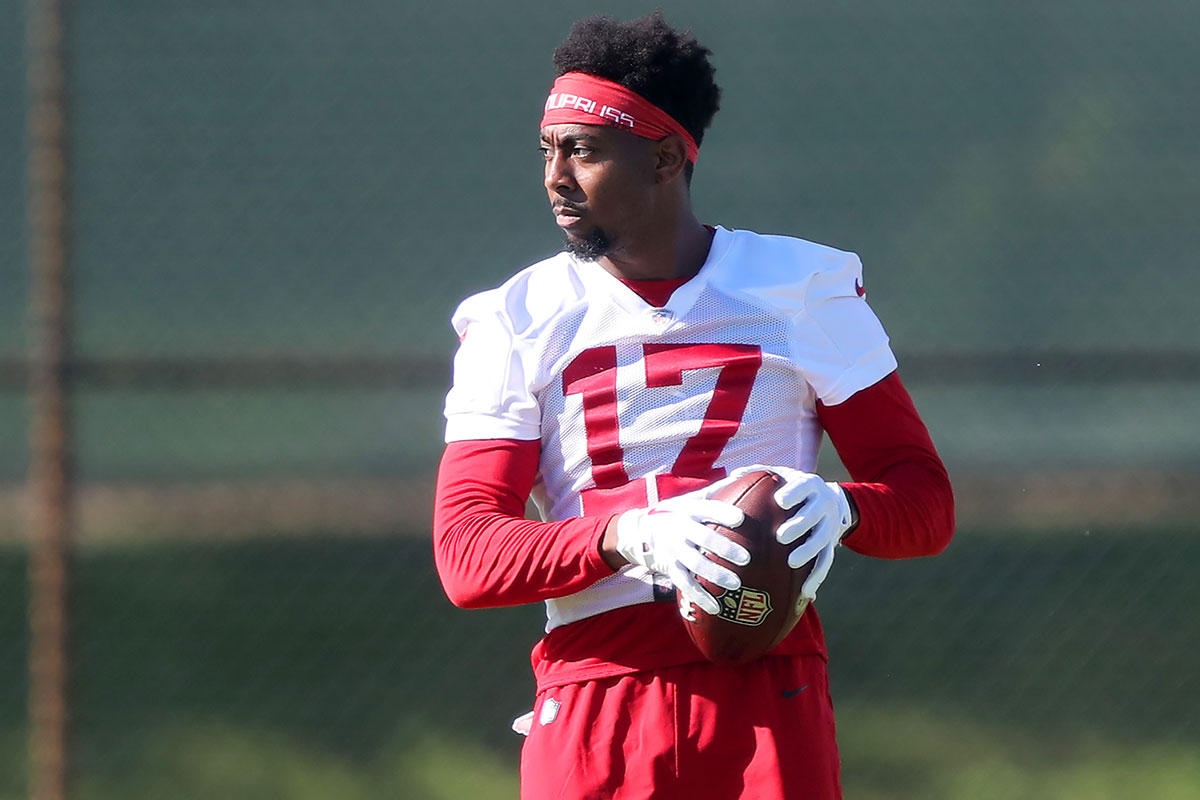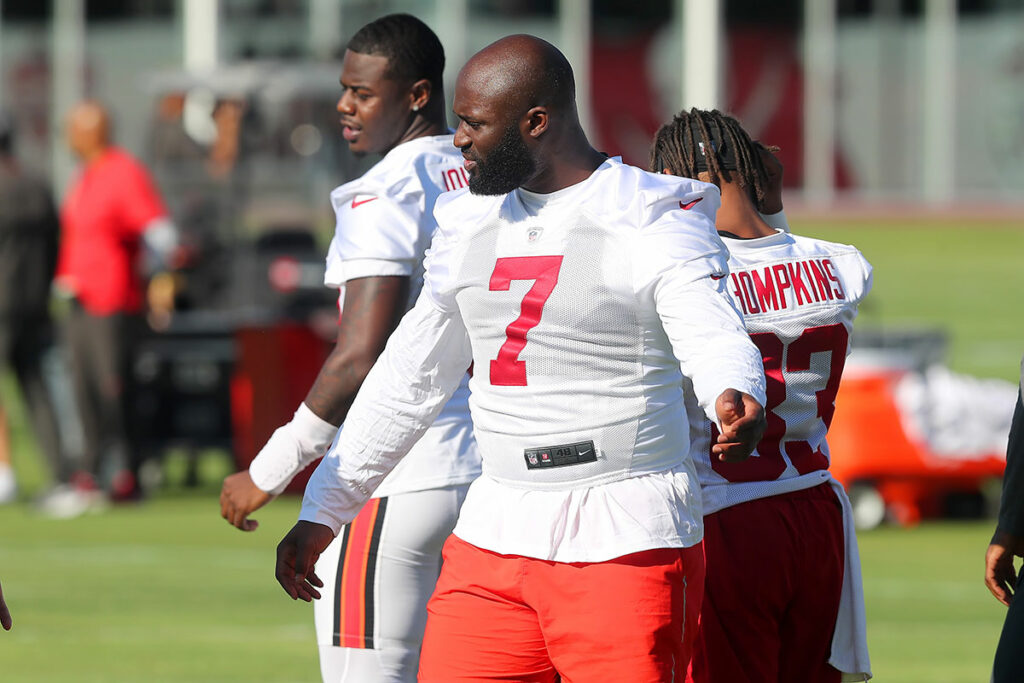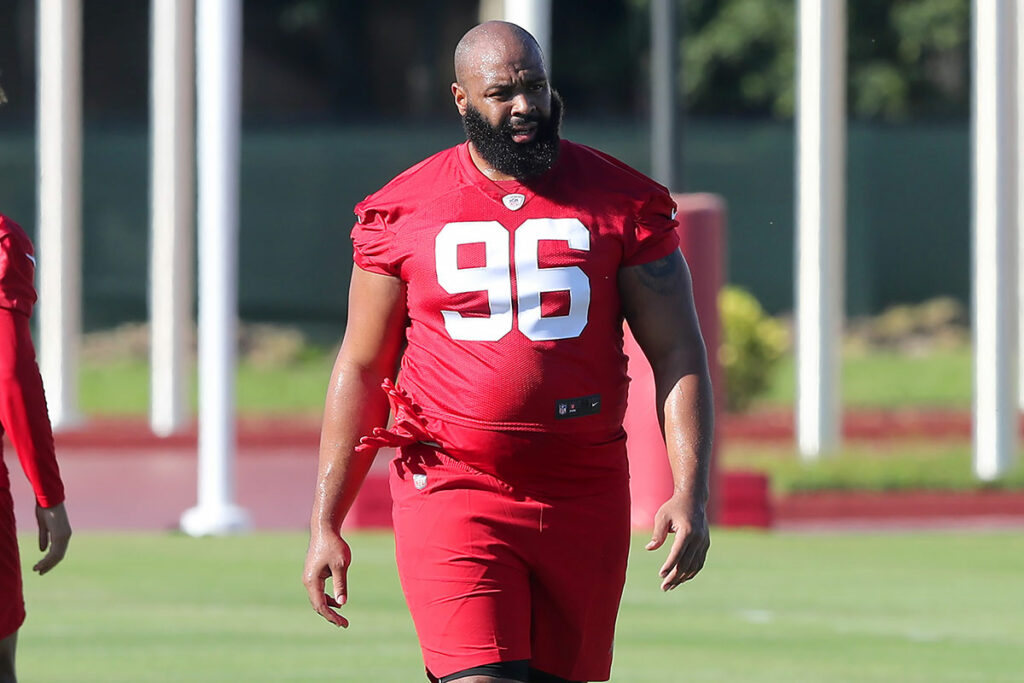Welcome back to another edition of “Grinding The Tape.” This week, we will continue our look at Bucs’ offseason additions, this time with a focus on new wide receiver Russell Gage.
Gage recently signed a three-year, $30 million contract with the Bucs. He will slot in as the Bucs’ WR3 once Chris Godwin fully recovers from his knee injuries from last year. Until then, Gage projects as Tampa Bay’s second receiving option behind Mike Evans. And Gage has experience as a second option, having spent a good portion of last year as such with the Falcons. During much of that campaign, he was option two behind tight end Kyle Pitts in Atlanta.
Over Gage’s four-year career, he has developed a reputation as a short yardage, move-the-chains type of receiver. This has been due to two reasons. First, Gage has spent the majority of his reps in the slot. Of his 1,393 career passing snaps, over 60% have been from the slot.
Secondly, Gage’s usage has been mostly relegated to shorter chain-moving routes. That’s not to say he can’t win deep (more on that later), just that he hasn’t been asked to do so too much. That has led to Gage posting a lackluster 10.7 yards per catch over his 193 career receptions.
Last year, a lot of that changed, as it was the first year since his rookie campaign that he played less than 50% of his snaps from the slot. Last year also marked the highest average depth of target since his rookie year as well.
Over the course of today’s column, we are going to look at six (!) different areas of Gage’s game as they relate to what he will be asked to do in the Bucs’ offense. They are his ability to create separation, get deep, make contested catches, perform from the slot, create with the ball in is hands and block.
I watched four of Gage’s games from last year. They were Week 1 against Philadelphia, Week 13 against Tampa Bay, Week 15 in San Francisco and Week 18 against New Orleans. Now, let’s dive in!
Creating Separation
I would argue this is the most important part of playing wide receiver these days. Straight up, can you get open? The answer with Gage is most certainly yes, he can. According to the NFL’s NextGen Stats, Gage registered an average of 3.1 yards of separation on his routes in 2021. This ranked No. 33 among wide receivers with at least 40 catches. The tape backs this up. Gage uses a strong drive off the line to create solid burst, as well as a suddenness in his cuts and breakdowns to leave defenders scrambling to stay close to him. And he is able to do it through a variety of routes.
Curl Route
Let’s start with a simple curl route, shall we? Now, on this play, Gage is opposite the play side read on the outside. Matt Ryan never sees him because the play isn’t supposed to come to his side. But that doesn’t mean it isn’t a great example of the kind of separation Gage can create. Against soft coverage from the corner, Gage drives out of his stance with power. He is able to break down from that drive quickly. Had the read been to Gage, Ryan could have had an easy completion for nine yards.
This part of Gage’s game really shines through most. It is probably a big reason why, for much of his career, he has been used on these types of routes that are designed to pick up small chunks of yardage with little opportunity to create after the catch. Gage’s ability to break down from a full sprint is extremely impressive.
Hitch Route
Now, let’s take a look at a close cousin of the curl route. The hitch asks much of the same from the receiver. It’s just designed to evolve over an ever shorter distance.
Again, Gage is being asked to do many of the same things as the last play. Drive off the line with force. Break down quickly. This time, it’s happening over about 5-7 yards rather than 9-10. And again, he isn’t the primary read. It looks to me like he would have been the second read in the progression. In retrospect, he was the better read as his corner carried the slot receiver vertically and the nickel read the out route by the tight end perfectly. This led to Pitts getting hit immediately as the ball arrived while Gage had no one around him for five yards at the bottom of the screen.
Out Route
Now let’s look at how Gage creates separation when we add a horizontal element to his routes.
Hopefully you are starting to see a trend with Gage’s burst off the line. The immediacy of his ability to get to full speed put both the corner and safety into a full-court press to stop him deep. So, when Gage cuts to the outside, there is over four yards of separation between him and the corner. You’d love to see Ryan pull the trigger on the pass just a second sooner and this would have been a first down. Instead, he delays his release, and it winds up being a 3-yard gain. You have to imagine on a play like this, Tom Brady is getting the ball out sooner and the play goes for a bigger gain.
In Route
Okay, he can create room for himself to the outside. But can he do it to the inside where there is more traffic? Absolutely. This is a man who has made his living off of working in traffic.
Here, Gage is at the bottom of your screen as the outside receiver to the strong side. Philadelphia is playing a strong underneath zone package. Gage runs a deep in. As the tight end Pitts releases outside, he draws both the outside corner and the inside nickel to him. Ryan goes with his first option in Pitts. But let’s go back Gage. His deep in route is wide open due to him spacing the route for maximum room between the deep safety and the linebacker, who has to account for the slot receiver on the short cross.
Dig Route
Now, let’s put several parts together. Let’s go horizontal in both directions.
Here, Gage’s route initially looks like a slant, but then he cuts it off. It almost seems like he is supposed to sit on it. But then, you see him open it up to the outside for a dig. Why the slow development to the route? From what I can see, I think it was intentional. Since this is play-action, it is going to develop slowly. If Gage snaps his route immediately, he is going to be fighting the sideline by the time the ball gets to him. By slowing the transition, he gives himself and Ryan plenty of room to allow for an easy catch and some YAC. In any event, look at his defender as he does all of this. Oh wait, what defender? There’s no one near him.
Shake Route
Now to fully round out Gage’s ability to get open throughout the entire route tree, let’s look at him running a shake route.
A shake route is best executed when faking a corner route to get the cornerback to open his hips. Against a single-high look like this, the deep safety is unable to cover the ground created by the inside leverage when the receiver then moves inside on the eventual post. And you can see Gage execute this against the Bucs and Pierre Desir masterfully. Desir bites on the outside move, and Gage slides right into the Bermuda Triangle of open space between him, Ross Cockrell, and Lavonte David. While this wasn’t a catch, it wasn’t for a lack of Gage being open.
Gage As A Deep Threat
As I covered earlier, Gage has been primarily used as a short-to-intermediate weapon over his young career. It didn’t make sense to me, as he has legit 4.3 speed. So, what was preventing Atlanta from using him as a deep threat? I wish I knew. I don’t have any insightful analysis for you. The guy can be effective in that role.
Against New Orleans, he is running a deep nine route. Since the corner is playing up, Gage decides to release inside. As he gets about ten yards deep, he encounters the safety who came down on the play fake. Watch closely for the hip wiggle. This causes the safety to break in, fearing the possibility of the crosser. But no, Gage keeps carrying the route vertically, leaving the safety to effectively cover 15 yards of pure nothing. As the play nears its conclusion, Gage hasn’t created a ton of room between him and the corner, but he does have the inside leverage. A better thrown ball would have likely led to a big completion.
Here is one more. It’s a high-low concept against quarters coverage. The route is a good call against this defense, as it puts a ton of pressure on the outside corner to decide which route he is going to commit to. Gage is the front side of the stack at the top of your screen. He is going to run the high route. Clean release with good acceleration. He gets to his mark, creating a ton of room after the corner bites on the low. It’s my hope after watching Gage that the Bucs give him more opportunities to operate vertically this year.
Contested Catch Ability
The Bucs offense does not scheme players open as much as other offenses in the NFL do. It requires its receivers to win one-on-one more often. In doing so, it requires receivers to be able to make contested catches in order to be successful. Does Gage have this ability? Absolutely. As Jon Ledyard noted in his Bucs Briefing back in March, Gage caught 58% of his contested catch opportunities in 2021. And the tape backs this up a ton.
Watch how he does it twice in San Francisco on the same fade route, with one resulting in a fantastic touchdown grab.
First off, kudos to the corner on both plays. You’d be hard-pressed to find any fault in how he covered these fade routes. He is draped all over Gage in both instances. Gage just Moss’d him both times. I was particularly impressed with the first one. Look at the moment Ryan decides to make the throw. There is no separation. And yet he has all the faith in the world that Gage can go up and get it. And go up and get it he does.
Also, for fun in that clip, look at how Gage beats the press. His first step is actually to take his right foot and slide it behind and to the inside of his left foot. It gives the impression that he is blocking. He then throws his outside shoulder inside before swiping the corner inside to get him the room to get off the line on the fade. I don’t know if this was taught to him or if he developed it himself, but it is really cool and I hope to see him utilize it with the Bucs.
Gage In The Slot
Gage has extensive experience in the slot. And that theoretically should be a huge boon for the Bucs. Late last year, the offense had trouble adjusting to life without Chris Godwin due to the lack of a strong option “B” for them in the slot. Tyler Johnson just could not do the things that Godwin could, and with the importance of that role in the offense, the team suffered. While Gage has experience as a slot receiver, it has been in a different type of slot role. So, can he do what Godwin does? You bet.
The Bucs offense asks their slot receiver not to win on quick timing routes that scheme the receiver open for YAC. It asks the receiver to win vertically. Above, you can see Gage on another shake route pushing him deep. But this time, he does it from the slot position. It’s all there. A strong release off the line. The corner fake that opens his defender’s hips to the outside. The transition to the corner route underneath the single-high safety. The only thing missing here was the catch. The ball wasn’t thrown perfectly, but that’s a catch Gage should make.
A lot of what Gage was asked to do from the slot in Atlanta’s offense was to sit on hitch routes. With the Bucs, he will be asked to carry the seam more. Look for him to excel in this role.
Beating Press Coverage
You saw Gage beat press coverage on both of his contested catch reps earlier. Here’s one more for good measure.
Watch as Gage fakes an outside move before driving his shoulder through the corner’s jam for inside leverage. Masterclass. The rest of the rep is impressive as well. He gets the corner off balance at the top of his route with an inside fake before turning for the corner. Finally, he shows great ball skills holding on through contact while dragging his feet.
Creating With The Ball In His Hands
Last year, Gage recorded an average of 4.1 yards after catch, according to NextGen Stats. This was No. 38 among wide receivers with at least 40 catches. It also represents 0.4 yards per reception more than expected. It’s not the strongest part of his game, but he is still solidly above average in it.
Here, he gets a pop pass from Ryan while in motion. This entire play is centered on Gage’s ability to get yards while the ball is in his hands. Watch as the safety crashes down to blow up the play. Gage’s reaction? “Not today, Satan!” He calmly hurdles the safety, keeps his balance, generates another four yards before shaking the linebacker attempting to tackle him from behind. Gage follows this by redirecting inside and lunging forward for another couple of yards. He turned what should have been a 4-yard gain into a 16-yard explosive play.
Here’s another example of Gage’s ability to get up-field with the ball in his hands. This is a designed flat to him that doesn’t start well. Right off the snap, the receiver in the slot to his right immediately gets pushed backward, cutting off Gage’s horizontal path. Meanwhile, the right tackle pushes Shaq Barret into perfect position to bring Gage down. With Sean Murphy-Bunting gaining outside leverage, Gage has no choice but to cut up-field and try to shake Barrett. He is able to successfully do so while keeping his balance, breaking Carlton Davis’ would-be tackle with a spin move. From here, it’s just incredible to watch him remain upright and gain extra yardage with another spin move to prevent Antoine Winfield. Jr. from bringing him down. I’m sure the Bucs are happy he will be doing things like this for them in 2022 instead of against them.
Gage As A Blocker
If you are a receiver in the Bucs offense, you are going to be expected to block. And Gage has the goods here as well. He isn’t a highlight reel machine in this area, but most wide receivers aren’t. And with his thin frame, it would be difficult for him to create pancake blocks. But he combines a willingness with a good understanding of body positioning. This leads to him being effective in this area. Here are two examples of just that.
In the first, he uses his whole body to get into Murphy-Bunting’s core and push him away from the play. He does the same thing with the second against New Orleans, with some added oomph to really stick the outside corner.
When the Bucs signed Gage this offseason, it took most everyone by surprise. However, looking through his tape, it is clear to see that he is a perfect fit for what they look for in a receiver. He provides excellent depth on both the outside as well as in the slot. And I am personally really excited to see how offensive coordinator Byron Leftwich can unlock his talents further in 2022.
Josh Queipo joined the Pewter Report team in 2022, specializing in salary cap analysis and film study. In addition to his official role with the website and podcast, he has an unofficial role as the Pewter Report team’s beaming light of positivity and jokes. A staunch proponent of the forward pass, he is a father to two amazing children and loves sushi, brisket, steak and bacon, though the order changes depending on the day. He graduated from the University of South Florida in 2008 with a degree in finance.




